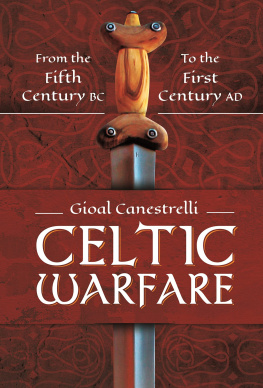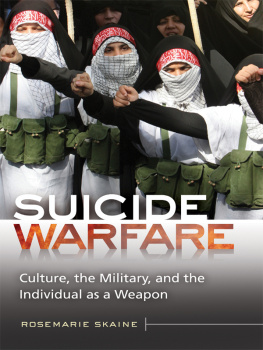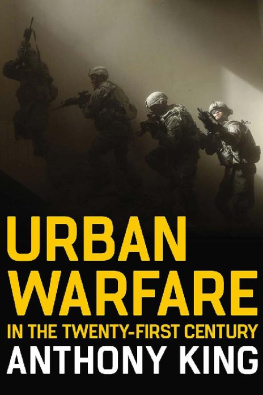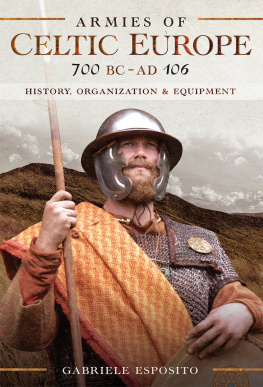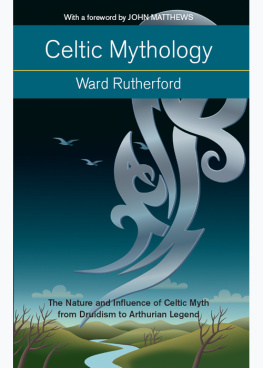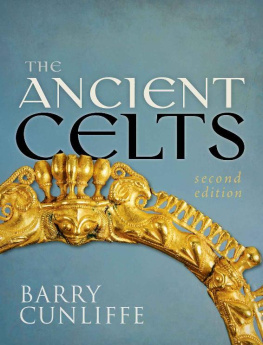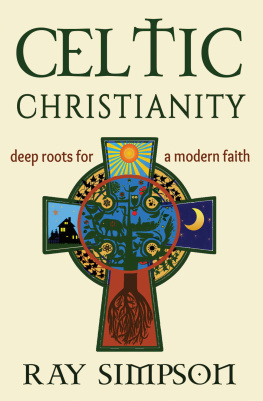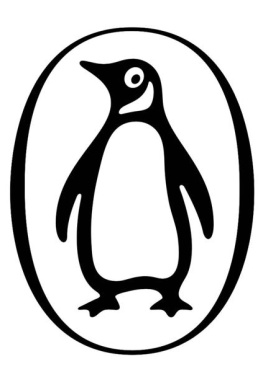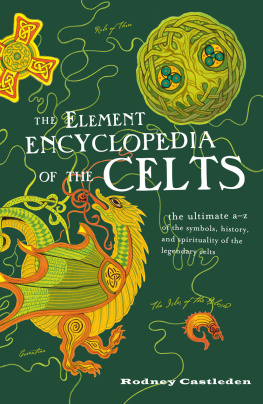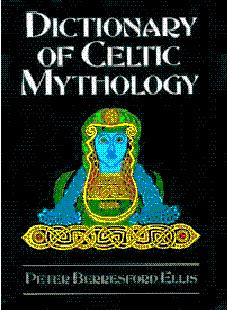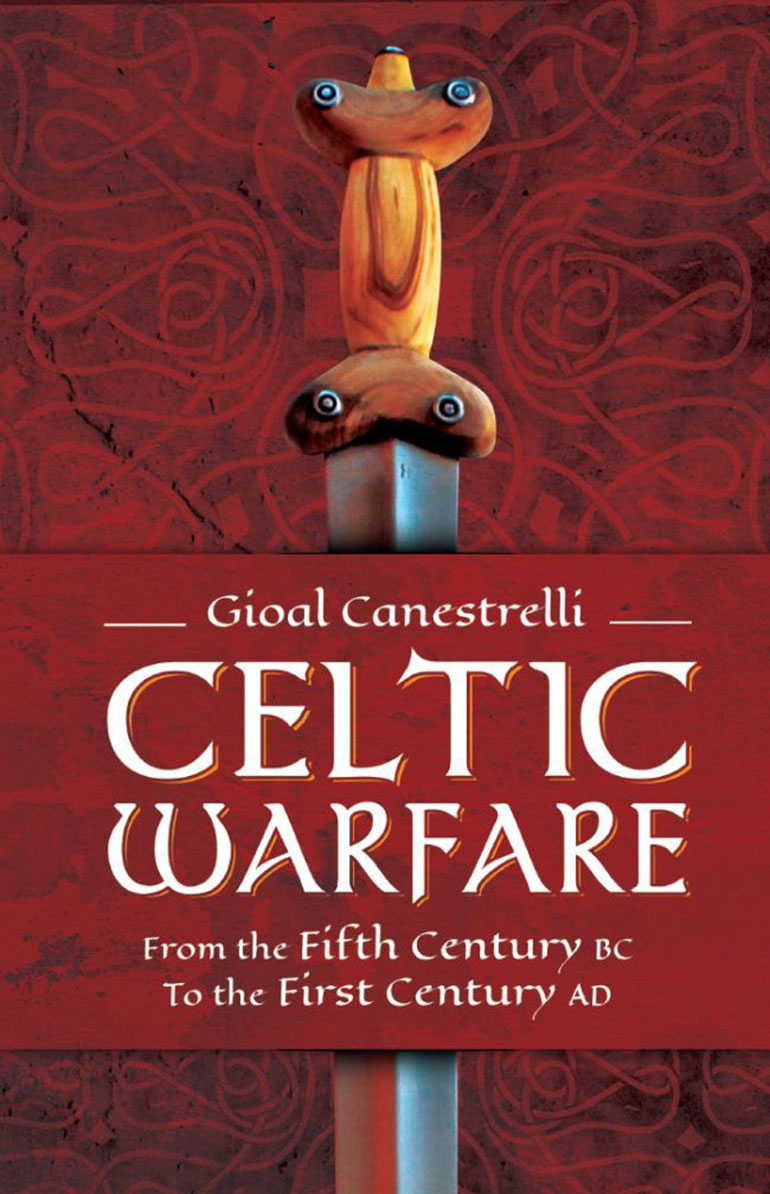Celtic Warfare
Celtic Warfare
From the Fifth Century BC to the First Century AD
Gioal Canestrelli
Artwork by Damiano Coppa
Colour Plates by Francesca Mattioli and Alice Bulgarelli
First published in Great Britain in 2022 by
Pen & Sword Military
An imprint of
Pen & Sword Books Ltd
Yorkshire Philadelphia
Copyright Gioal Canestrelli 2022
ISBN 978 1 39907 017 1
eISBN 978 1 39907 018 8
The right of Gioal Canestrelli to be identified as Author of this work has been asserted by him in accordance with the Copyright, Designs and Patents Act 1988.
A CIP catalogue record for this book is available from the British Library.
All rights reserved. No part of this book may be reproduced or transmitted in any form or by any means, electronic or mechanical including photocopying, recording or by any information storage and retrieval system, without permission from the Publisher in writing.
Pen & Sword Books Limited incorporates the imprints of Atlas, Archaeology, Aviation, Discovery, Family History, Fiction, History, Maritime, Military, Military Classics, Politics, Select, Transport, True Crime, Air World, Frontline Publishing, Leo Cooper, Remember When, Seaforth Publishing, The Praetorian Press, Wharncliffe Local History, Wharncliffe Transport, Wharncliffe True Crime and White Owl.
For a complete list of Pen & Sword titles please contact
PEN & SWORD BOOKS LIMITED
47 Church Street, Barnsley, South Yorkshire, S70 2AS, England
E-mail: enquiries@pen-and-sword.co.uk
Website: www.pen-and-sword.co.uk
Or
PEN AND SWORD BOOKS
1950 Lawrence Rd, Havertown, PA 19083, USA
E-mail: Uspen-and-sword@casematepublishers.com
Website: www.penandswordbooks.com
War should not be studied as an end in itselfwe must use war as an expression of civilization, being one of the most eloquent.
Jacques Harmand
To my father, who gave me the passion for military history
Contents
Plates
With the passage from Hallstatt to La Tne culture, Celtic warbands started to spread throughout Europe. These two noble combatants are an example of V century BC La Tne aristocracy.
The warrior on the left wears a tall Berru helmet in copper alloy and a tube and yoke armour with a peculiar gorget-like humeralia as seen from the statues of Glanum and Roquepertuse. His full-iron javelin, a gaesum or soliferrum, is both a weapon and a status-symbol, while the sword carried on the right side is inspired by the longest specimen of that time.
The structure of the shield is hardened by an iron bar running over the wooden umbo, with four bronze appliques as further reinforcements and decorative elements
The warrior on the right, inspired by the Glauberg stelae and the combatants of the Hallstatt scabbard, is wearing a simple Bockweiler helmet in iron and a tube and yoke armour made of crenellated segments. His small shield and relatively short sword with a deadly point are compatible with a dynamic combat style.
The conquest of a huge portion of northern Italy strongly affected the equipment of Celtic warriors.
The figure on the left is a Senones mercenary, whose rich panoply may have been acquired thanks to the money earned fighting for the Greeks of Syracuse.
His helmet, an iron Celto-Italic with the typical three-lobed cheek-pieces, is inspired by the find from the Euryalus fortress in Syracuse, while the tube and yoke armour, and the richly embossed bronze scabbard are taken from the finds in the Senones necropolis of S. Paolina di Filottrano. The shield, with its iron bivalve umbo covering the wooden spina and reinforcing metal bar, is inspired by the depiction of a Gaulish shield on an Etruscan pottery from Volterra.
The warrior on the right is a Boii chieftain and wears a bronze Montefortino helmet surmounted with a pair of metal foil horns as seen in several finds from northern Italy. The model depicted is specifically inspired by the specimen found in grave 132 of the Boii necropolis of Monte Tamburino di Monte Bibele. Furthermore, his sword comes from grave 94 of the same necropolis, and is an excellent weapon with a strong and sharp blade and a scabbard with a large pierced chape.
The shields metal elements and the pilum javelin are also inspired by the findings from Monte Bibele, precisely the materials from Monterenzio Vecchio grave 3, while the shield decoration pattern is taken from the depiction on an Etruscan pottery from the Leipzig Museum.
His tube and yoke armour is a linothorax, inspired by a passage of Silius Italicus Punica about the linen cuirass of the Boii chieftain Crixus, while the shape of the crossed humeralia is taken from a bronze figurine from Glauberg.
After testing the power of Macedon with some minor expeditions in the Balkans between the last years of the IV century BC and the first years of the III century BC, the Pannonian Celts launched a large-scale attack against Greece thanks to the efforts of both the newly established Celtic communities of the Carpathian Basin and the fierce Volcae warbands from Bohemia and Moravia.
The combatant on the left is a Pannonian levy infantryman from one of the communities settled in the Carpathian basin and was not originally a member of the warrior class.
His helmet is a bronze Celto-Italic of the Eastern sub-type directly inspired by a specific finding that went through various modifications and repairs, such as the addition of a neck-guard and anatomic cheek-pieces in substitutions to the original three-lobed ones. As a main weapon he carries a long thrusting spear, the celtic lankia, inspired by the Greek dory, while his secondary weapon is a simple butcher knife, used as a weapon by the Eastern Celts as reported by Diodorus (XVI, 94, 3). The shape and decoration pattern of his shield are both taken from a Hellenistic clay figurine resembling a Celtic warrior kept in the British Museum.
The second combatant is a professional from the Volcae Tectosages warbands equipped with a sword and a spear useful both as a throwing weapon and in close combat.
His iron Eastern Celto-Italic helmet is attested by both actual findings and iconography, and both his shield and armour, an iron mail shirt, are inspired from the Celtic weapons depicted on the reliefs in the sanctuary of Athena Nikephoros in Pergamon.
After the Romans conquered the Ager Gallicus, massacred the Senones Gauls and founded the colony of Ariminum, the Celtic peoples of Cisalpine Gaul became weary of the Roman expansionism. A mighty alliance was therefore forged between the Insubres, the Boii and the Taurini, and many Gaesatae mercenaries were recruited from the Rhne Valley.
A huge Celtic army marched south and defeated the Romans in Etruria, but was confronted and soundly defeated by two consular armies at Cape Telamon while trying to return home with a rich booty.
The first warrior on the left is one of the Insubres, the strong Celtic confederation whose capital city was Mesiolano, known today as Milan. He is not a noble, but a rich merchant or craftsman, which makes his equipment of fine but not best quality. His sword is a long slashing weapon, not too sharp, whose blade may be low-quality, prone to bend.

